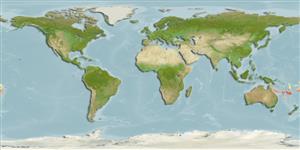Élasmobranches (requins et raies) (sharks and rays) >
Myliobatiformes (Stingrays) >
Urolophidae (Round rays)
Etymology: Urolophus: Greek, oura = tail + Greek, lophos = crest (Ref. 45335); papilio: papilio meaning butterfly, in reference to the particularly broad wingspan of the disc of this species (Ref. 51067).
More on authors: Séret & Last.
Environment: milieu / climate zone / depth range / distribution range
Écologie
marin bathydémersal; profondeur ? - 330 m (Ref. 51067). Deep-water
Western Central Pacific: Chesterfield Islands.
Length at first maturity / Taille / Poids / Âge
Maturity: Lm ?, range 31 - ? cm
Max length : 31.3 cm TL mâle / non sexé; (Ref. 51067)
Description synthétique
Morphologie | Morphométrie
Vertèbres: 147 - 153. Broad disc, width exceeding 70% total length; short tail, postcoacal length less than three-quarters of disc length; long snout, exceeding 17% total length; broad, rectangular internasal flap, width subequal to interspace between 5th gill slits; inner margin of spiracle parallel to longitudinal axis; tail folds rudimentary or absent; small dorsal fin; apices of pelvic fins rounded; single row of 10-13 oral papillae; no broad lobes on posterolateral border of nostrils; 104-110 pectoral fin radials; dorsal surface uniform yellowish brown (Ref. 51067).
Inhabits the continental slope (Ref. 51067). Adult size unknown (Ref. 51067). Minimum depth from Ref. 58018.
Life cycle and mating behavior
Maturité | Reproduction | Frai | Œufs | Fécondité | Larves
Séret, B. and P. Last, 2003. Description of four new stingarees of the genus Urolophus (Batoidea: Urolophidae) from the Coral Sea, South-West Pacific. Cybium 27(4):307-320. (Ref. 51067)
Statut dans la liste rouge de l'IUCN (Ref. 130435)
Menace pour l'homme
Harmless
Utilisations par l'homme
Plus d'informations
Taille/ÂgeCroissanceLongueur-poidsLongueur-longueurFréquences de longueursMorphométrieMorphologieLarvesDynamique des populations larvairesRecrutementAbondanceBRUVS
RéférencesAquacultureProfil d'aquacultureSouchesGénétiqueElectrophoresesHéritabilitéPathologiesTraitementNutrientsMass conversion
CollaborateursImagesStamps, Coins Misc.SonsCiguateraVitesseType de nageSurface branchialeOtolithesCerveauxVision
Outils
Articles particuliers
Télécharger en XML
Sources Internet
Estimates based on models
Preferred temperature (Ref.
123201): 16.8 - 20.6, mean 18.8 °C (based on 10 cells).
Phylogenetic diversity index (Ref.
82804): PD
50 = 0.5000 [Uniqueness, from 0.5 = low to 2.0 = high].
Bayesian length-weight: a=0.00813 (0.00366 - 0.01807), b=3.08 (2.88 - 3.28), in cm total length, based on LWR estimates for this (Sub)family-body shape (Ref.
93245).
Niveau trophique (Ref.
69278): 3.5 ±0.4 se; based on size and trophs of closest relatives
Résilience (Ref.
120179): Faible, temps minimum de doublement de population : 4,5 à 14 années (Assuming fecundity<100).
Fishing Vulnerability (Ref.
59153): Low vulnerability (21 of 100).
